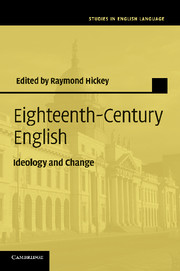Book contents
- Frontmatter
- Contents
- List of figures
- List of maps
- List of tables
- Notes on contributors
- Preface
- 1 Attitudes and concerns in eighteenth-century English
- 2 Prescriptivism and the suppression of variation
- 3 Women's grammars
- 4 Eighteenth-century women and their norms of correctness
- 5 Lowth as an icon of prescriptivism
- 6 Queeney Thrale and the teaching of English grammar
- 7 Coalitions, networks, and discourse communities in Augustan England: The Spectator and the early eighteenth-century essay
- 8 Contextualising eighteenth-century politeness: social distinction and metaphorical levelling
- 9 Expressive speech acts and politeness in eighteenth-century English
- 10 Variation and change in eighteenth-century English
- 11 Variation in sentential complements in eighteenth- and nineteenth-century English: a processing-based explanation
- 12 Nationality and standardisation in eighteenth-century Scotland
- 13 English in eighteenth-century Ireland
- 14 Changes and continuities in dialect grammar
- 15 ‘Be pleased to report expressly’: the development of a public style in Late Modern English business and official correspondence
- 16 Registering the language – dictionaries, diction and the art of elocution
- Timeline for the eighteenth century
- References
- Late modern English language studies
- Indexes
2 - Prescriptivism and the suppression of variation
Published online by Cambridge University Press: 06 December 2010
- Frontmatter
- Contents
- List of figures
- List of maps
- List of tables
- Notes on contributors
- Preface
- 1 Attitudes and concerns in eighteenth-century English
- 2 Prescriptivism and the suppression of variation
- 3 Women's grammars
- 4 Eighteenth-century women and their norms of correctness
- 5 Lowth as an icon of prescriptivism
- 6 Queeney Thrale and the teaching of English grammar
- 7 Coalitions, networks, and discourse communities in Augustan England: The Spectator and the early eighteenth-century essay
- 8 Contextualising eighteenth-century politeness: social distinction and metaphorical levelling
- 9 Expressive speech acts and politeness in eighteenth-century English
- 10 Variation and change in eighteenth-century English
- 11 Variation in sentential complements in eighteenth- and nineteenth-century English: a processing-based explanation
- 12 Nationality and standardisation in eighteenth-century Scotland
- 13 English in eighteenth-century Ireland
- 14 Changes and continuities in dialect grammar
- 15 ‘Be pleased to report expressly’: the development of a public style in Late Modern English business and official correspondence
- 16 Registering the language – dictionaries, diction and the art of elocution
- Timeline for the eighteenth century
- References
- Late modern English language studies
- Indexes
Summary
Towards a standard of pronunciation
It is generally agreed that Received Pronunciation as a distinct and widely recognised sociolect did not exist before the nineteenth century and was not named as such until Ellis used the phrase to describe a pronunciation used ‘all over the country, not widely differing in any particular locality’ (1869–1889: 23). However, as Raymond Hickey has reminded us in the introduction, the notion that one type of pronunciation was superior to others had been around at least since the sixteenth century, when most commentators broadly agreed with Puttenham (1589) that the ‘best’ pronunciation is ‘the vsuall speach of the Court, and that of London and the shires lying about London within lx myles’. What is lacking from these early accounts is any prescription or proscription of specific features: readers are told where and from whom the most prestigious pronunciation can be heard, but are not advised to adopt or avoid any particular sequence of phonemes. In the early seventeenth century Alexander Gil provides what Dobson acknowledges to be ‘the best account of seventeenth-century dialectal pronunciation’ (1957: 142), giving examples of Northern, Western and Eastern pronunciations, but recommending that only the ‘Common Dialect’ should be used, at least in prose. He uses terms such as ‘barbarous’ to refer to regional pronunciations, and reserves his strongest condemnation for a social group which he calls the ‘Mopsae’, who appear to be advanced speakers carrying forward changes ‘from below’ which have their geographical origin to the East of London.
- Type
- Chapter
- Information
- Eighteenth-Century EnglishIdeology and Change, pp. 21 - 37Publisher: Cambridge University PressPrint publication year: 2010
- 13
- Cited by



